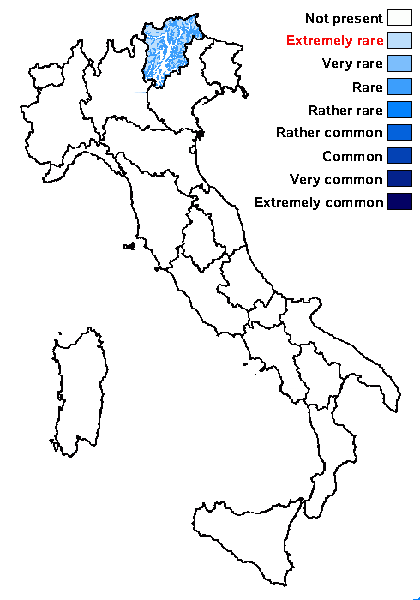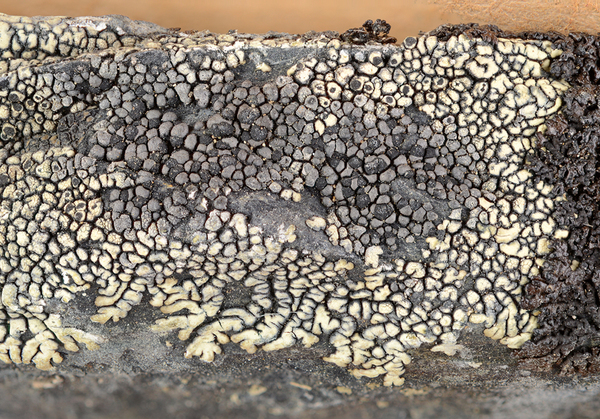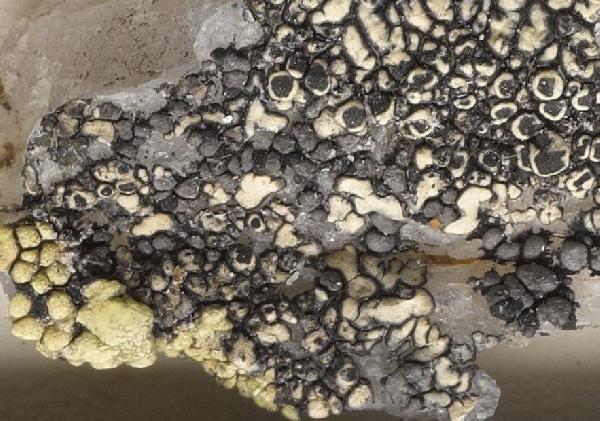Rhizocarpon renneri Poelt
Planta, 51: 306, 1958.
Synonyms:
Distribution: N - TAA.
Description: Thallus crustose, bluish grey to dark grey, areolate, forming 5-10(-20) mm wide patches on the thalli of Dimelaena oreina, with a dull black hypothallus developing among the areoles. Areoles strongly convex, constricted at base at maturity, round to angular, usually contiguous, 0.3-1 mm wide, occasionally the inner ones disintegrating. Cortex poorly differentiated, 5-15 µm thick, overlain by an up to 10 µm thick epinecral layer; medulla white, I+ pale blue. Apothecia lecideine, black, dispersed, to 0.8 mm across, round, with a convex to strongly convex disc and a soon excluded proper margin. Epithecium violet-brown, K+ purple-red or K-; hymenium colourless, 100-140 µm high, K/I+ blue; paraphysoids branched and anastomosing, 1-1.5 µm thick at mid-level, the apical cells capitate; hypothecium brown-black. Asci 8-spored, clavate, fissitunicate, with a well-developed tholus that is K/I- in lower part and K/I+ blue near the apex, lacking an ocular chamber, Rhizocarpon-type. Ascospores muriform, with 5-7 cells visible in optical view, brown-black and almost opaque, ellipsoid, 16-22 x 9-12 µm, halonate at least when young. Photobiont chlorococcoid. Spot tests: medulla K-, C-, KC-, P-. Chemistry: without lichen substances.Note: on steeply inclined or rain-sheltered surfaces of siliceous rocks, starting the life-cycle on the thalli of Dimelaena oreina; probably more widespread, but never common, in the dry valleys of the Alps.
Growth form: Crustose
Substrata: rocks
Photobiont: green algae other than Trentepohlia
Reproductive strategy: mainly sexual
Subcontinental: restricted to areas with a dry-subcontinental climate (e.g. dry Alpine valleys, parts of Mediterranean Italy)
paras Dimelaena oreina
Commonnes-rarity: (info)
Alpine belt: extremely rare
Subalpine belt: rare
Oromediterranean belt: absent
Montane belt: rare
Submediterranean belt: absent
Padanian area: absent
Humid submediterranean belt: absent
Humid mediterranean belt: absent
Dry mediterranean belt: absent

Predictive model
Growth form: Crustose
Substrata: rocks
Photobiont: green algae other than Trentepohlia
Reproductive strategy: mainly sexual
Subcontinental: restricted to areas with a dry-subcontinental climate (e.g. dry Alpine valleys, parts of Mediterranean Italy)
paras Dimelaena oreina
Commonnes-rarity: (info)
Alpine belt: extremely rare
Subalpine belt: rare
Oromediterranean belt: absent
Montane belt: rare
Submediterranean belt: absent
Padanian area: absent
Humid submediterranean belt: absent
Humid mediterranean belt: absent
Dry mediterranean belt: absent

Predictive model
 INDEX FUNGORUM
INDEX FUNGORUM
 GBIF
GBIF
 DOLICHENS
DOLICHENS



